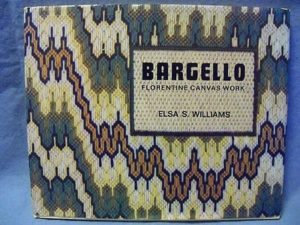
Updated November 20, 2018
If you like Bargello, you probably buy lots of old books. There were tons of them published in the 70’s, and relatively few since then.
Because the designs are timeless, this isn’t really a problem. Just update the colors and you’re good to go.
But are you?
Today we expect our patterns to be nicely charted out for us on graph paper. We can see how long the stitches are, we can see in symbols how the pattern moves.
While many older books have charted patterns, many do not. Still others have hand-drawn charts. This column will help you make the best use of these older books.
If the book has charts with printed symbols, just go ahead and use it. Though produced with different tools, they are the same as the charts we create today. Often, because they are larger, they may be easier to see.
Handle hand-drawn charts (on paper with a grid) exactly the same way. Before we all had computers, many books, especially self-published ones, had hand-drawn charts. If they are a bit hard for you to follow, rechart them for your own use.
Other hand-drawn charts don’t use symbols in each square but draw lines for each stitch instead. I find these the most maddening of all. Remember that each line is a stitch. I will often rechart these.
Still others have sketches that aren’t on grids at all. Barbara Snook’s books, my favorite Bargello books, are like this. Happily she does put on the length of the stitch and the size of the step. Although I have stitched a few pieces directly from her sketches, those patterns were very small. For larger patterns, I’d chart the design out myself.
Many books, including Elsa Williams’ Bargello, have no charts at all. They do haVe close up pictures of the patterns. Using your knowledge of Bargello for the size of the step and length of the stitches, you can figure out the pattern.
For vintage patterns that are line patterns, i.e. no open or closed shapes, you can skip the charting step and just stitch your pattern in the middle of the area for your project.
Another maddening aspect of many older books and charts is that they include color numbers but don’t tell you the thread. Often they are for threads that do not exist. Because it’s the pattern thar is of interest, ignore the numbers and stitch in threads and/or colors of your choice.
Don’t be afraid of vintage Bargello books — they have great stuff in them!
About Janet M Perry
Janet Perry is the Internet's leading authority on needlepoint. She designs, teaches and writes, getting raves from her fans for her innovative techniques, extensive knowledge and generous teaching style. A leading writer of stitch guides, she blogs here and lives on an island in the northeast corner of the SF Bay with her family

Bargello has always been one of my favorite stitches…
Dorothy Kaestner Bargello Antics
Needlepoint Bargello both by Scribners pub.
Margaret Boyles. Bargello Workbook by Macmillan pub.
Another stitch book I liked was. Trianglepoint by Sherlee Lantz Viking Press. I coludidos go on and on with great books that probably would show my age but nonetheless I can say I still get ideas and colors from them
Bargello has always been one of my favorite stitches…
Dorothy Kaestner Bargello Antics. and
Needlepoint Bargello both by Scribners pub.
Margaret Boyles. Bargello Workbook by Macmillan pub.
Another stitch book I liked was. Trianglepoint by Sherlee Lantz Viking Press. I could go on and on with great books that probably would show my age but nonetheless I can say I still get ideas and colors from them
If anyone want this triangle point book I have one for sale right now on FB